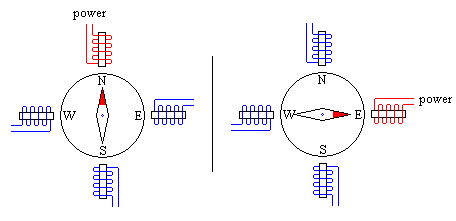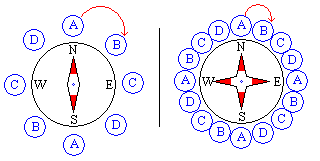
General Theory of Stepper Motors
An ordinary DC motor will turn around and around as long as power is supplied. No intelligent circuitry is required to drive such a motor, unless you want to slow it down or reverse direction – just apply power and it spins. A stepper motor is very different. If you just feed it power, it will stay where it is. In order to make the motor move, you have to feed it a changing signal. This is best illustrated by thinking of a magnetic compass with electromagnets around it:

Figure 2.7.1 Motor Stepper
The drawing on the bottom shows power applied to the N electromagnet, drawing the compass toward it. On the right, power is instead applied to the E electromagnet, and the needle has rotated toward that side.

Figure 2.7.2. Basic Stepper Motor
Just four electromagnets would give coarse jumpy motion. Now imagine a similar arrangement with 100 electromagnets around the compass. By energizing each electromagnet in sequence, the needle takes 100 steps around the circle. But driving 100 individual electromagnets would require complex electronics. We fake it:

Figure 2.7.3. Basic Motor Stepper with more electromagnet
In these drawing, the circled letters represent electromagnets. All the magnets with the same letter are wired together. When you energize that circuit, all of the electromagnets torn on at once. On the left, there are 8 magnets, but only 4 circuits. Sequencing through the four circuits gives half of a rotation. One more run through the sequence completes the rotation. This setup requires that both ends of the compass needle be north-seeking. On the right, the same 4 circuits energize 16 magnets. This setup requires 16 steps (4 repetitions of a 4-step cycle) to complete one rotation.
On the right, the same 4 circuits energize 16 magnets. This setup requires 16 steps (4 repetitions of a 4-step cycle) to complete one rotation. In actual practice, just four control wires can provide just about as many steps as you might want. One of the characteristics of a given stepper motor is the number of steps necessary to make a complete circle, usually expressed as number of degrees per step.
Table 2.7.1. Full Step Mode
| Comment | ||||
| Take a step clock wise | ||||
| another step clock wise | ||||
| another step clock wise | ||||
| another step clock wise | ||||
| No step take | ||||
| Take a step back |
More Complex Drive
As we have seen, it is very easy to drive a stepper motor, by simply turning one electromagnet fully on at a time. But there are other ways to drive a stepper motor.
Half Steps
By turning on two coils at once, the motor will take a position between the two steps.

Figure 2.7.4. Half step mode
Table 2.7.2. Half Step Mode
| Comment | ||||
| Take a step clock wise | ||||
| Half a step clock wise | ||||
| The complete full step clock wise | ||||
| another half step clock wise | ||||
| The complete full step clock wise | ||||
| Another half step clock wise | ||||
| The complete full step clock wise | ||||
| another half step clock wise | ||||
| Start position |